Machine guns in the general system of armament of the Red Army in the Great Patriotic War
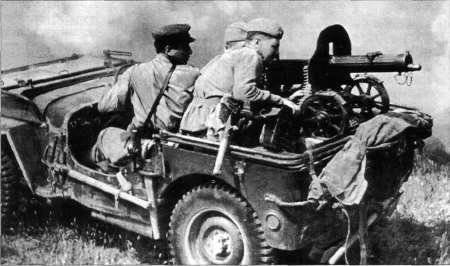
The total number of machine guns produced during World War II:
- II half of 1941 g. - 106200 units. (during the evacuation of the Tula Arms Plant);
- I half 1942 g. - 134100 units. (at the plant number 526 (Stalinsk) produced DP, at the plant number XXUMX (Izhevsk) - "Maxim", at the plant number XXUMX (Zlatoust) - "Maxim", at the Tula machine-building plant in this period resumed production of "Maximov", in g Kuybyshev was producing HDCs);
- II half of 1942 - 222000 units;
- I half 1943 g. - 236000 units;
- II half of 1943 g. - 222500 units. (at the plant number 2 (Kovrov) started the production of SG-43);
- I half 1944 g. - 230500 units. (at the plant number 54 (Zlatoust) also started the production of SG-43);
- II half of 1944 - 208600 units;
- I half 1945 g. - 117500 units.
During the war years, the following quantities of machine guns were supplied to the USSR armed forces (taking into account weapons from prewar stocks as well as lend-lease supplies):
II half year 1941 of the year - 45300 manual, 8400 machine, 1400 large-caliber;
1942 year - 172800 manual, 58000 machine, 7400 large-caliber;
1943 year - 250200 manual, 90500 machine, 14400 large-caliber;
1944 year - 179700 manual, 89900 machine, 14800 large-caliber;
I half 1945 year - 14500 manual, 10800 machine, 7300 large-caliber.
If 100% is the number of weapons in the Red Army on 1 January 1942, then on 1 January 1943, the number of submachine guns and rifles will be 180% and 1 January 1944, 280% and 210%, respectively. In defense, the average density of rifle-and-machine gun fire increased from 450-1,2 bullets per minute per linear meter in the first period of the war to 1,6-9 bullets per minute in the third period. At the same time, the depth of the continuous rifle fire decreased to 12 meters, since the main contribution was made by submachine guns.
In the Army of the Soviet Union during the Second World War consisted of:
22.06.1941 of the Year - 170400 light machine guns, 76300 heavy machine guns, 2200 large-caliber;
01.01.1942 of the Year - 81000 light machine guns, 30000 heavy machine guns, 2200 large-caliber;
01.01.1943 of the Year - 177100 light machine guns, 63500 heavy machine guns, 4700 large-caliber;
01.01.1944 of the Year - 344500 light machine guns, 133000 heavy machine guns, 18200 large-caliber;
01.01.1945 of the Year - 418100 light machine guns, 184700 heavy machine guns, 31100 large-caliber;
09.05.1945 of the Year - 405400 light machine guns, 182600 machine guns, 37500 large-caliber.
During the war, the importance of machine-gun fire remained in the military air defense and air defense of the country. From the 3837 aircraft that were shot down by the front forces in the period from 22 June 41 of the year to 22 of June 42 of the year, 295 was shot down by anti-aircraft machine gun installations, 268 - by rifle and machine gun fire of the troops. In the air defense of Moscow on 22 June 1941, there were 105 anti-aircraft machine guns, on 1 January 42, 511, on 1 October 44, 686. The number of machine guns in the country's air defense during the war increased 12,1 times, as a rule, these were heavy machine guns. Their role in the country's air defense by the end of the war decreased, but increased significantly at the front. Despite the fact that the use of heavy machine guns in the production of barrier fire gave the benefit, it could not completely replace the special anti-aircraft installations. Large-caliber machine guns were much more effective than machine guns of normal caliber, however, here too, machine tools with a free lead were inferior to installations having a mechanical or electromechanical targeting drive and more advanced sights.
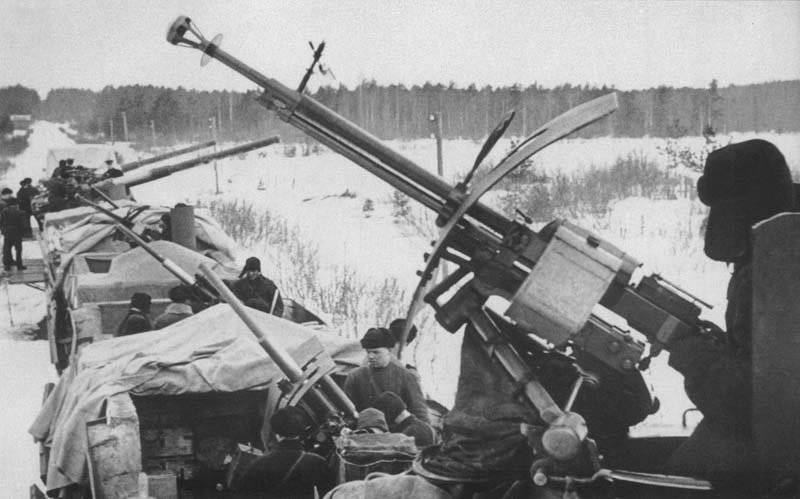
Changes in personnel and saturation of the rifle division of the Red Army with automatic weapons (by state):
Personal: April 1941 - 14483 people; July 1941 g. - 10859 people; December 1941 g. - 11626 people; December 1942 g. - 9435 people; December 1944 g. - 11706 people; June 1945 g. - 11780 people;
The total number of submachine guns in the same periods was: 1204 pcs. (or 83 units per 1000 person); 171 (15,75 to 1000); 582 (50 to 1000); 727 (77 to 1000); 3594 (307 to 1000); 3557 (302 to 1000);
The total number of light machine guns in the same periods was: 392 pcs. (or 27 to 1000 people); 162 (15 to 1000); 251 (21,5 to 1000); 494 (52,4 to 1000); 337 (28,8 to 1000); 383 (32,5 to 1000);
The total number of machine guns in the same periods was: 166 pcs. (or 11,5 to 1000 people); 108 (10 to 1000); 109 (9,4 to 1000); 111 (11,76 to 1000); 166 (14,2 to 1000); 178 (15,1 to 1000);
The number of shots from the machine guns per minute; April 1941 g. - 297460; July 1941 g. - 140470; December 1941 g. - 190930; December 1942 g. - 204710; December 1944 g. - 491160; June 1945 g. - 492720.
In different periods of the war, a change was observed in the weapons system not only of the USSR but also of Germany:
In December 1941, the personnel of the German infantry division numbered 14742 people. (Infantry Division of the USSR - 11626 people.) At the same time in service there were 705 submachine guns (528 in the USSR), 454 light machine guns (251 in the USSR), 112 machine guns (109 in the USSR). In addition, the German infantry division did not have anti-aircraft machine gun installations while the Soviet rifle division was armed with 33 anti-aircraft machine-gun installations, including large-caliber ones.
At the beginning of 1943, the personnel of the German Infantry Division numbered 13656 people. (Soviet rifle division - 9435 people.) In service there was a 681 submachine gun (727 in the USSR). At this time, the German troops did not have light and heavy machine guns, and the rifle division was armed with 494 light and 111 heavy machine guns. With regard to anti-aircraft machine-gun systems, the situation has changed - there was an 18 20-mm anti-aircraft machine-gun system in an infantry division and this type of armament was absent from a rifle division. It should be noted that at the beginning of 1943, the Guards Rifle Division (10670 personnel) had 166 machine and 499 light machine guns and 1097 submachine guns; separate rifle brigade (4197 people) - 36 machine guns and 109 light machine guns, motorized rifle brigade (4000 men) - 36 machine guns and 98 light machine guns.
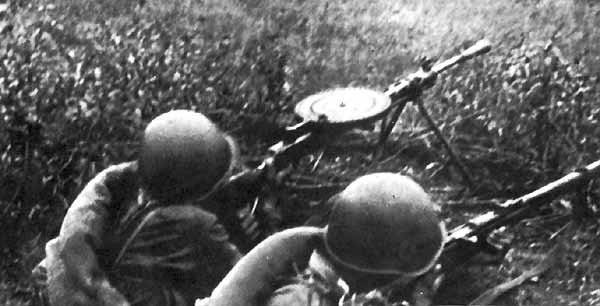
In December 1944, the personnel of the German infantry division numbered 12801 people. (Soviet rifle division - 11706 people.) In service there were 1595 submachine guns and assault rifles (3594 in the USSR), 614 light machine guns (337 in the USSR), 102 heavy machine guns (166 in the USSR). The rifle division during this period was armed with 18 12,7-mm anti-aircraft machine-gun systems.
Before World War II, the idea was partially resuscitated that a mass self-loading rifle can take on some tasks that can be solved with light machine guns. However, practice has shown that just the use of light machine guns removes the relevance of “automatic” high-power rifles. The experience of the war led to a revision of the range of use of small arms, downward due to increased density of artillery and mortar fire, the widespread use of assault aviation и tanks. The “Infantry Battle Charter” of 1942 (BUP-42) established that machine gun fire is valid for ranges of up to 1000 meters, “however, it is better to conduct sudden fire at distances of 600 meters or less” (“close” ranges), light machine guns - up to 800 meters. Light machine guns on air targets fired at ranges of less than 500 meters, easel machine guns with an anti-aircraft sight - less than 1000 meters, with a conventional sight - less than 500 meters. For comparison: before the war, the firing range of light machine guns was set in the range from 800 to 1200 meters, easel machine guns for ground targets - 3000-5000 meters, for air targets - up to 1500 m.However, the increase in saturation with artillery did not reduce the value of machine guns.
After the division of the order of battle into the forging and assault groups, the light machine gun began to always operate in the chain of separation. During the offensive, the machine gun was usually put forward first to a new position (the fire could be fired while on the move), and when leaving the battlefield - the last. A machine gunner as part of a tank assault force suppressed anti-tank weapons and covered the actions of the shooters. Tanks for heavy machine guns often played the role of "machine-gun".
Service requirements have been changed. At the beginning of 1942, competitions were announced for lighter and light machine-guns, submachine guns. The work was carried out in two directions: the modernization of the Degtyarev infantry machine gun and the development of a new light machine gun; one fighter could carry out the maintenance and carrying along with the ammunition load.
The machine gun at that time was the main group fire weapon of infantry (infantry) units capable of firing intensive fire with a 250-300 fire rate of fire per minute. Machine-gun companies equipped with machine-gun machine guns, as a rule, were attached to rifle companies as a rule. According to BUP-42, the machine-guns distributed into the depth and along the front covered the advancement of the unit, supported the attack, struck the enemy’s heavy weapons calculations, advanced into the depths and flanks, reflected the counterattack. Indirect fire practically did not use fire, as well as shooting over the heads. As a rule, machine guns fired from behind the flanks and in between.
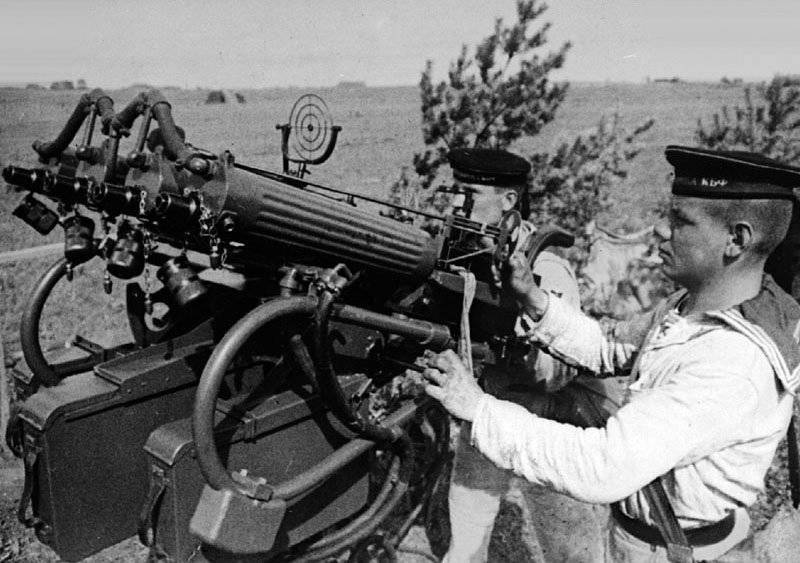
Shooting at long ranges still led, for example, at crossings or in the mountains, but even in these cases the range did not exceed 3000 meters. Reducing the range allowed, first, to reduce the range of used cartridges (cartridges with heavy bullets were excluded), and second, to raise the issue of creating a lightweight machine gun. However, the dimensions of the heavy machine gun, the time spent on changing positions and preparing for firing, did not allow these machine guns to be advanced to the forward lines, as they might be late with the reaction to the revived enemy firing points or his counterattack. In settlements, woods and mountains the bulkiness of machine guns was especially sensitive.
Their capabilities and power, heavy machine guns showed in defense. At the same time, the position was adapted for firing at various ranges and to the requirements of all-round defense. Machine-gun fire in the strongholds provided the flanks and the gaps, covered the positions of artillery and anti-tank crews, put them in forward positions and points, isolated separate duty and "dagger" machine guns. It was practiced to create areas of barrage and concentrated fire of heavy machine guns, which were superimposed on areas of artillery and mortar fire.
Further development received fire facilities for machine guns. For example, during the Battle of Stalingrad in the city 200 DZOTov was created, 37 armor and reinforced concrete caps for machine guns were installed. Greater attention was paid to firing in the dark, training in the calculation of reference points and lines, as well as methods of fixing the crosstalk with artificial dispersion in depth and along the front. The quick maneuvers of heavy machine guns, the importance of which is especially important during defense on a broad front, were difficult even after switching to a trench system with full profile trenches.
The transition to a new weapons system began in the middle of the war. The appearance of a lightweight machine gun became possible after an intermediate-power cartridge was created, but the production of the RPD was started only in the last months of World War II. But on the arms of the Red Army among the new models were accepted easel machine guns SG-43. The quick and successful implementation of the developmental reserve and combat experience accumulated before the war showed the creation of an effective system for designing, testing and putting into production.
The predilection of the Red Army commanders for the machine-gun wheeled machine is explained by the fact that such a machine allowed the machine gun to be moved ready for firing (most machine guns on tripod machine tools had to be removed from the machine tools and reinstalled in a new position) . The experience of military operations showed the advantages of a tripod machine with the ability to conduct anti-aircraft fire in front of universal and wheeled machines.
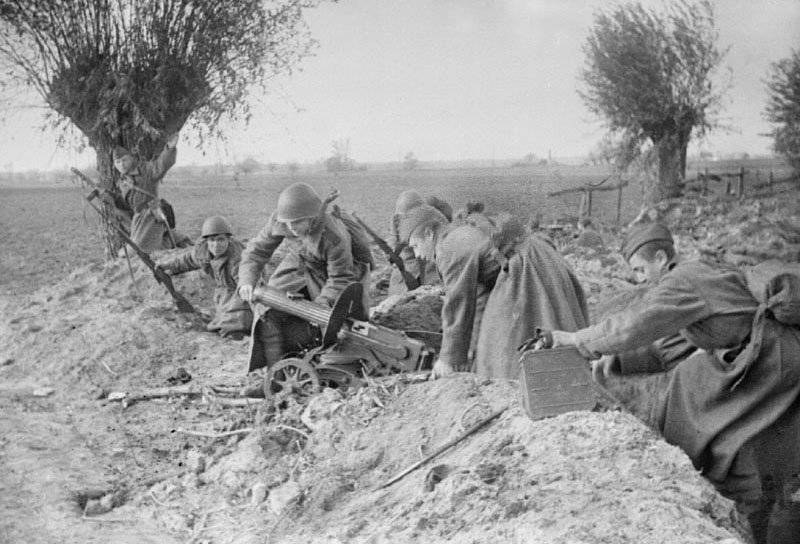
Despite the fact that large-caliber machine guns according to the “Manual on small business” were intended “for firing at air targets” as well as “for fighting enemy fire points and manpower with concealed light armor,” the main task for them was anti-aircraft weapons. As a rule, they fired at air targets at ranges of less than 1,5 thousand. The anti-aircraft guns were usually located no further than 300-500 meters from the front edge of the defense. With the help of these machine guns were covered with command posts, front-line roads and railways. For example, in May 1943 of the year 558 heavy machine guns were used to protect the rail lines of the fronts. During the war years, anti-aircraft machine guns (quad "Maxims" and DShK) shot down an enemy 2401 aircraft. Firing on low-flying, high-speed targets increased the requirements for combat rate of fire and the possibility of using them in complexed installations (it was embodied in the modernization of the AAC).
But the possibility of long-range shooting, the penetration of bullets (for fighting in the city or the mountains), the increase in the share of light armored vehicles were not ignored - for example, the DShK had to be used in anti-tank defense during the Kursk battle.
During the war revealed the need for more powerful machine guns. To solve this problem in the USSR returned to the machine guns under the 14,5-millimeter cartridge. In some countries, preferred to use automatic small-caliber guns. At the final stage of the war, the delivery of a large-caliber DShK machine gun to the troops did not decrease, in contrast to the easel and light machine guns.
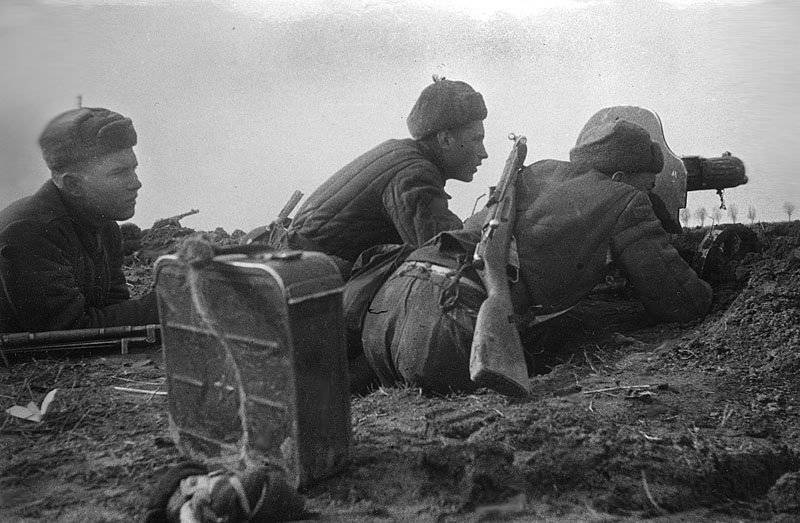
During the war, did not stop searching. For example, in 1942-1943, the need to facilitate light machine guns was the reason for the creation of BC Deykin, N.М. Afanasyev and V.F. Fierce on the Scientific Test Site of the small arms of the LAD machine gun with tape feed under the 7,62 mm pistol cartridge TT. The deterioration of shooting accuracy was one of the main reasons for the general desire to increase the density of fire. It is not surprising that there were installations of “heavy fire”, such as an experienced 8-barreled machine gun I.I. Slostina
Information